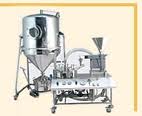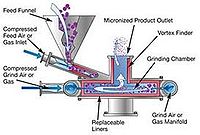Jet Mills
Jet Mills are used for the superfine grinding of a wide range of specialist materials when other forms of grinders are unsuitable, particularly in cases where the feed material is hard or already relatively fine and where high purity products, without contamination, are required. Material is ground by attrition by introducing high-energy air jets through a series of nozzles and is combined with an integral rotary classifier wheel. This single unit enables accurate and highly controllable product sizes to be achieved with sharp cut off and a typically narrow size distribution.
Common Features
- Integral forced-vortex classifier provides accurate control of product size
- On-stream adjustment of product size by variable speed classifier rotor
- Generation of superfines controlled by adjustment of jet velocity
- Feed entry configuration allows pre-classification of product prior to milling
- Suitable for handling highly abrasive materials
- Ability to accept some feed stock up to 3mm reduces need for pre-grinding
- Low operating temperatures enable heat-sensitive material to be processed
- Manufactured in mild steel or stainless steel
- Alternative materials available for wear parts and/or mill linings
- Low operational noise levels
- Easy access for clean-out and maintenance
- Negative pressure within the milling chamber provides dust free operation
- Complete with automatic control system
Operation
Pulverization takes place in the central chamber of the jet energy mill as the process material is driven at near sonic velocity around the perimeter of the toroidal chamber by multiple jets of air or steam. No grinding media is involved. Size reduction is the result of the high-velocity collisions between particles of the process material itself. The interior of the chamber is designed to allow recirculation of over-sized particles, enhancing the incidence and the effect of these collisions. As particles are reduced in size and progressively lose mass, they naturally migrate toward the central discharge port, making precise classification both automatic and precisely controllable.
The process involves no moving parts or screens and is suitable for virtually any friable or crystalline materials, even materials that are very abrasive. And, since contamination can be avoided and no excess heat is produced, jet pulverizers are suitable for materials that must remain ultra-pure and those that are heat sensitive. Even cryogenic applications can be accommodated. Further, by precise metering of the product input and air or steam velocity, highly predictable and repeatable graduation and classification of the finished particles is possible.
Common Types
- Laboratory Jet Mills
- Fluidized Bed Jet Mills
- Spiral Jet Mills
Video

